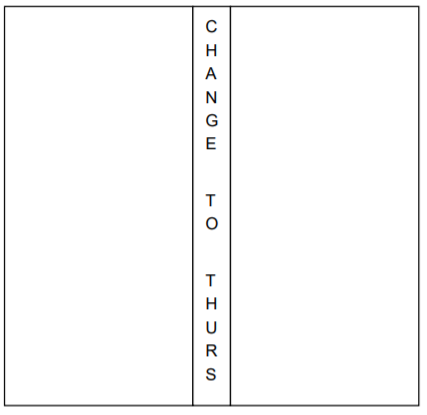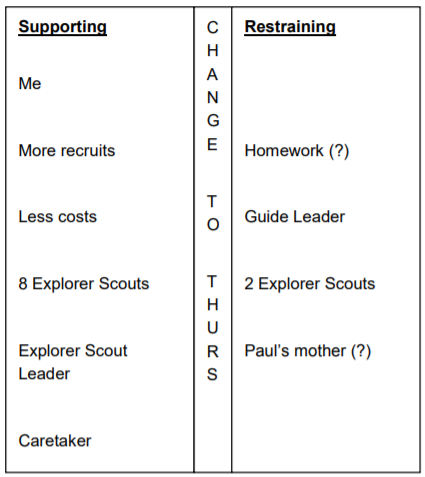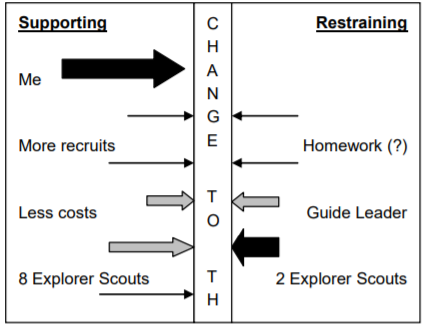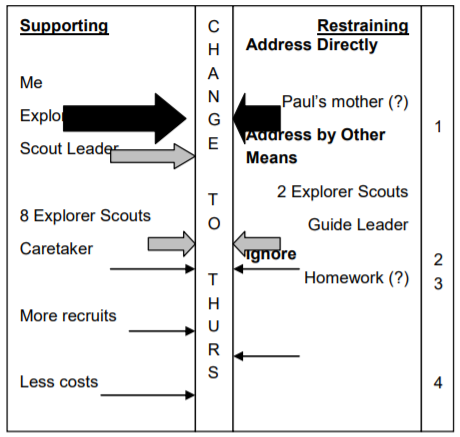Force field analysis
The subject of managing change is a complex one. Thousands of words have been written on the subject and clearly there is no one simple answer.
Force field analysis
Step 1
Clearly identify the result of the change that you wish make (how you make the change will come later). Let us take as a simple example you wish to move the Unit meeting night from Friday to Thursday.
Draw this as:

Step 2
Create two lists, one for all those factors and people in favour of the change (driving forces) and one for all the factors and people who will be against the change (restraining forces).
For our example let's assume the following:
Factors
Few scouts are joining the Unit and the most often given reason is they go out on Friday or go to football training. The hall is only used by the Unit on a Friday and so the Unit has to pay the full rental and for the caretaker. Weekday homework and college work might be a problem for the unit members.
People
8 Explorer Scouts are in favour of the change and two, Paul and Kim are against. The Explorer Scout leader is in favour as is the Caretaker. The Guide Leader, who uses the hall early on Thursdays, is against and you also expect Paul's mother, who is on the Group Executive, might also object.
Draw these factors as:

Step 3
Around each force draw an arrow pointing to the centre. The arrows can be of different sizes to identify their relative power.
Alternatively you might use colour to identify importance, for example, red, amber, green or you might colour code people and factors differently.
It might help to put related features next to, or facing each other. For example the 8 venture scouts opposite the 2 venture Scouts.
In our example, let us assume that Paul's mother is actually the major force because if she is not convinced you know she will complain at length and loudly to everyone.
Our diagram would now look like this:

Step 4
Redraw your force field to create your strategy. Identify supporting forces that you wish to strengthen, or put together with other driving forces, or to put opposite particular resisting forces.
Identify restraining forces you wish to address directly, those you will address by other means and those you will ignore. Having finished your diagram, number each item and write down the specific action you will make happen (not necessarily do yourself) in a priority order.
Our final example might look like this:

Actions
- Item 1 – Find out if there is another Unit that meets on Friday night and then talk to Paul's mum about why you are proposing the change.
- Item 2 – Ask Kelly to talk to Kim about staying in the Unit.
- Item 3 – Get the Caretaker to reassure the Guide Leader.
- Item 4 – Ignore.
Step 5
Review the process regularly and redraw the map as necessary. Add more factors or people as appropriate and delete those that no longer apply.
In our example map, if Paul's mum accepts and understands the change she can be removed as a restraining force. If she still objects you might have to make her arrow thicker and consider who else might get involved and what their position is, such as the Group Executive.
Summary
The example given is deliberately simple but hopefully helps you to understand the process. This type of analysis can be used for very extensive projects.
It's worth remembering that the process is designed to help you understand both sides of the argument and not just to help you „win‟. As such, it's a useful tool if you're considering a change as well as for managing changes that you have to make.